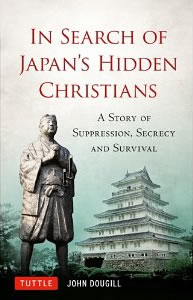Book Notes
 John Dougill, In Search of Japan's Hidden Christians; A Story of Suppression, Secrecy and Survival (Tokyo: Tuttle Publishing, 2012), 231pp.
John Dougill, In Search of Japan's Hidden Christians; A Story of Suppression, Secrecy and Survival (Tokyo: Tuttle Publishing, 2012), 231pp.
On August 15, 1549, Francis Xavier, one of the founders of the Jesuits, landed on the shores of Japan and founded the first Catholic mission in that country. Protestants didn't arrive for another 300 years (1861–1862). For about a century Catholic missionary efforts enjoyed varying degrees of success, with as many as 300,000 converts, until 1650 when the "contagion" of the western faith was brutally expunged. Executions, crucifixions, sadistic tortures of all kinds, prohibitions against preaching, edicts, the demolition of churches, the expulsion of missionaries, and the famous "fumie" in which people trampled an image to prove their renunciation of Christianity, ensued for two hundred years. By some estimates the Japanese exterminations of Christians were worse than the Portuguese Inquisition (97). When Christianity was once again tolerated in 1854, guess what? Seven generations of so-called "Kakure Kirishitan" or "Hidden Christians" were discovered. Without any clergy, Bibles, churches or liturgy, these mainly illiterate believers had survived by going underground and practicing their faith in secret.
John Dougill has spent most of his adult life in Japan, where today he is a professor of British studies. His book tells the 460 year-old story of Japan's Hidden Christians. The story is both personal and historical, as Dougill visits various islands, churches, museums, and places of interest. This is a story with many layers. In the earliest days of the Catholic mission, open-minded leaders were as interested in trade relations with Portugal as they were the Christian faith. Language, culture, and customs were always a challenge. Left to their own selves, the uneducated peasants often concocted a syncretistic mishmash of an unorthodox faith, and even kept to themselves after Christianity was later tolerated. There are parallels, observes Dougill, when Jews were ordered to convert in Spain in 1492 or face expulsion, and marranos continued to practice Judaism secretly. Shusaku Endo's famous novel "Silence" (1965) drew upon the history of Japan's Hidden Christians. And for a Biblical precedent, there's Naaman the Syrian who after his conversion returned home and continued to worship Yahweh even while he bowed down in the pagan temple of Rimmon (2 Kings 5). Today there are an estimated 1,000 Hidden Christians still living, and it is to Dougill's credit that he's given voice to their story before they are all gone.


